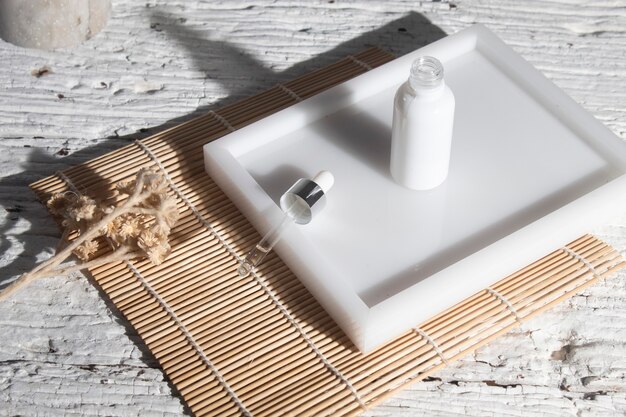Oily Skin SOS: Your 2025 Guide to Shine-Free Skin

Navigating oily skin in 2025 involves a nuanced approach integrating advanced skincare science with mindful lifestyle practices to effectively control shine and prevent breakouts, ensuring a clear, balanced complexion.
Living with oily skin often feels like a constant battle against shine and frustrating breakouts. If you’re seeking a definitive solution, this comprehensive guide, “Oily Skin SOS: The Updated Guide to Controlling Shine and Preventing Breakouts in 2025,” offers cutting-edge strategies and insights to help you achieve a balanced, clear, and radiant complexion.
Understanding Oily Skin in 2025: Beyond the Basics
Oily skin, characterized by an overproduction of sebum from hyperactive sebaceous glands, is a common concern affecting millions. While sebum is essential for skin health, moisturizing and protecting it, its excess leads to enlarged pores, a shiny complexion, and a higher propensity for acne and blackheads. In 2025, our understanding of this condition has deepened, moving beyond simple oil control to recognizing the interplay of genetics, lifestyle, environmental factors, and even the microbiome.
No longer is it about harsh stripping; instead, the focus is on achieving balance. Advances in dermatological research highlight the importance of maintaining the skin’s barrier function, understanding hormonal fluctuations, and recognizing the impact of diet and stress. These elements combine to create a comprehensive picture of what drives oiliness. Modern approaches emphasize gentle yet effective ingredients that regulate sebum without compromising skin integrity.
The Role of Genetics and Hormones
Genetics play a significant role in determining your skin type. If your parents have oily skin, chances are you will too. However, genetics are not a sole determinant; they merely predispose you. Hormonal fluctuations, particularly androgens, are primary drivers of sebum production. This is why many experience increased oiliness during puberty, menstruation, pregnancy, or periods of high stress.
- Estrogen and progesterone imbalances can also influence sebum.
- Insulin resistance may indirectly affect oil production.
- Stress hormones like cortisol can trigger sebaceous glands.
Understanding your hormonal patterns can guide your skincare choices and help in anticipating periods of increased oiliness. For example, some individuals may find specific ingredients more effective during certain phases of their menstrual cycle.
Environmental and Lifestyle Factors
Beyond internal factors, your environment and daily habits significantly impact oily skin. High humidity can exacerbate oiliness, as can certain dietary choices. Over-washing or using harsh products can strip the skin of its natural oils, ironically triggering even more sebum production in a compensatory response.
Pollution and UV radiation also contribute to oxidative stress, which can worsen inflammation and lead to more breakouts in oily skin types. A holistic approach acknowledges these external pressures and seeks to mitigate their effects through protective measures and a well-rounded routine. Adequate sleep and stress management techniques are also increasingly recognized for their positive impact on skin health.
Ultimately, managing oily skin in 2025 is about intelligent intervention. It involves selecting the right products, understanding your body’s signals, and adapting your routine to environmental shifts. This foundation allows for a proactive and effective strategy against shine and breakouts.
Advanced Skincare Ingredients for Oily Skin in 2025
The landscape of skincare ingredients is ever-evolving, and 2025 brings refined formulations and novel actives specifically targeting oily skin concerns. The goal is no longer just to “dry out” oil, but to truly balance sebum production, minimize pores, and prevent inflammation gently.
Choosing the right ingredients is paramount. It’s about creating a synergistic effect that addresses multiple facets of oiliness and breakouts without causing irritation or compromising the skin barrier. Consumers are becoming more discerning, demanding efficacy alongside skin-friendly profiles.
Topical Retinoids and Bakuchiol
Retinoids remain gold standards for oily and acne-prone skin due to their ability to regulate cell turnover and modulate sebum production. In 2025, a broader range of over-the-counter strengths and advanced delivery systems makes them more accessible and tolerable. For those sensitive to traditional retinoids, bakuchiol, a plant-derived alternative, gains further prominence for its retinoid-like benefits without the common side effects.
- Retinoids reduce follicular clogging by promoting skin cell exfoliation.
- They actively shrink enlarged pores over time.
- Bakuchiol offers similar collagen-boosting and anti-inflammatory effects.
The key is consistent, gradual introduction to avoid irritation, especially when starting a new retinoid product. Nighttime application is generally recommended.
Niacinamide (Vitamin B3)
Niacinamide has emerged as a powerhouse ingredient for oily skin, celebrated for its multifaceted benefits. It effectively reduces sebum production, minimizes the appearance of pores, and offers significant anti-inflammatory properties, making it excellent for breakout prevention and reduction of redness.
Moreover, niacinamide supports the skin’s barrier function, which is crucial even for oily skin types. A strong barrier prevents moisture loss and protects against environmental aggressors. Its versatility allows it to be incorporated into various product types, from cleansers to serums and moisturizers, often suitable for daily use.
Salicylic Acid (BHA) and AHAs
Salicylic acid (BHA) remains indispensable for oily and acne-prone skin due to its oil-solubility, allowing it to penetrate pores and exfoliate from within. This effectively dislodges dead skin cells and excess sebum, preventing blockages that lead to blackheads and whiteheads.
Alpha Hydroxy Acids (AHAs) like glycolic and lactic acid work on the skin’s surface, exfoliating and improving texture. While BHAs are superior for deep pore cleansing, AHAs complement them by enhancing overall skin smoothness and brightening the complexion. Strategic combination or alternation of these acids can yield optimal results without over-exfoliation.

Emerging and Supporting Actives
Beyond the well-established ingredients, 2025 also sees increased interest in specific peptides that can regulate sebum, prebiotics and probiotics for microbiome balance, and botanical extracts with proven anti-inflammatory and sebum-balancing properties like green tea extract or willow bark. These ingredients often serve as supporting players in complex formulations designed to offer comprehensive solutions for oily skin.
The collective aim of these advanced ingredients is to normalize skin function, not just suppress symptoms. This targeted approach allows for a reduction in shine and breakouts while fostering long-term skin health and resilience against future concerns.
Your Daily Skincare Routine for Oily Skin in 2025
A well-structured daily skincare routine is the cornerstone of managing oily skin. Consistency and the correct order of product application are as important as the products themselves. In 2025, the emphasis is on gentle yet effective steps that cleanse, treat, hydrate, and protect, without harsh stripping.
Each step plays a crucial role in maintaining skin balance, preventing excess oiliness, and minimizing the likelihood of future breakouts. Building a routine involves selecting products that complement each other and address your specific concerns, adapting it seasonally or as your skin changes.
Morning Routine: Cleanse, Treat, Hydrate, Protect
Your morning routine prepares your skin for the day ahead. Start with a gentle cleanser to remove overnight oil and impurities. Follow with targeted treatments and a lightweight moisturizer, always finishing with broad-spectrum SPF to protect against sun damage, which can exacerbate oiliness and post-inflammatory hyperpigmentation.
- Gentle Cleansing: Use a non-foaming or low-foaming cleanser with lukewarm water.
- Targeted Serum: Apply a niacinamide or antioxidant serum to control oil and provide environmental protection.
- Lightweight Moisturizer: Opt for an oil-free, non-comedogenic gel or fluid moisturizer.
- Sun Protection: A non-comedogenic, mattifying SPF 30+ sunscreen is essential.
This sequence ensures your skin is clean, treated, moisturized, and protected before facing environmental stressors.
Evening Routine: Double Cleanse, Treat, Repair
The evening routine focuses on thorough cleansing to remove makeup, sunscreen, and daily grime, followed by targeted treatments that work overnight, and a restorative moisturizer. Double cleansing is particularly beneficial for oily skin, ensuring pores are clear.
Begin with an oil-based cleanser or micellar water to break down makeup and SPF, then follow with a water-based cleanser. This prepares your skin for active ingredients like retinoids or salicylic acid, which are best applied at night. Finish with a moisturizer that aids in skin repair and hydration without feeling heavy.
Weekly Treatments and Spot Treatments
Beyond daily steps, incorporating weekly treatments can provide an extra boost. Clay masks can draw out impurities and temporarily reduce shine. Gentle exfoliating masks can help with cell turnover. For active breakouts, spot treatments with salicylic acid or benzoyl peroxide can be applied directly to the affected areas, helping to reduce inflammation and accelerate healing.
However, moderation is key. Over-treating can lead to irritation and compromise the skin barrier, potentially worsening oiliness or breakouts. Listen to your skin and adjust the frequency of these treatments as needed, focusing on supporting its natural balance rather than aggressively drying it out.
The adaptability of your routine is crucial. As your skin responds to products or as external factors change, be prepared to adjust product choices or application frequency. This personalized and informed approach ensures your oily skin remains balanced and healthy throughout 2025 and beyond.
Lifestyle and Diet: Their Impact on Oily Skin
While topical treatments are indispensable, managing oily skin effectively in 2025 increasingly acknowledges the profound impact of internal factors, specifically lifestyle choices and dietary habits. A holistic perspective recognizes that skin health is a mirror of overall bodily well-being. What you put into your body and how you live your life can significantly influence sebum production and inflammation.
This means moving beyond just external skincare and embracing a more integrated approach. Understanding these connections empowers you to take control of your skin from the inside out, leading to more sustainable and noticeable improvements.
Dietary Considerations for Oily Skin
The connection between diet and skin health, particularly acne and oiliness, is a growing area of research. While a direct, universal “oily skin diet” doesn’t exist, certain dietary patterns may exacerbate or alleviate symptoms for some individuals. High glycemic index foods and dairy products are often cited as potential triggers for increased sebum production and inflammation, leading to breakouts.
- High glycemic index foods (processed carbs, sugary drinks) can cause insulin spikes, potentially influencing hormones that stimulate oil glands.
- Dairy products might contain hormones that exacerbate acne in sensitive individuals.
- Omega-3 fatty acids (found in fish, flaxseeds) possess anti-inflammatory properties beneficial for skin.
Focusing on a diet rich in fruits, vegetables, lean proteins, and healthy fats can support overall skin health. It’s often beneficial to observe how your skin reacts to specific foods and adjust your diet accordingly, rather than adhering to rigid exclusionary diets without evidence.
Stress Management and Sleep Quality
The link between stress and skin conditions, particularly acne and oiliness, is well-documented. When you’re stressed, your body releases hormones like cortisol, which can stimulate sebaceous glands, leading to more oil production and increased inflammatory responses. Chronic stress can therefore perpetuate a cycle of breakouts.
Adequate, quality sleep is equally vital. During sleep, your body undergoes repair and regeneration processes. Insufficient sleep can elevate stress hormones and impair skin barrier function, making it more vulnerable to oiliness and breakouts. Prioritizing stress-reducing activities, like meditation, yoga, or spending time in nature, and ensuring 7-9 hours of quality sleep can significantly improve your skin’s condition.
Hydration and Exercise
Staying adequately hydrated is crucial for all skin types, including oily. While it won’t directly stop oil production, proper hydration ensures skin cells function optimally and can prevent the skin from compensating for dehydration by producing excess oil. Drinking plenty of water daily also supports the body’s detoxification processes.
Regular exercise improves blood circulation, which nourishes skin cells and helps clear cellular debris. Sweating during exercise is healthy, but it’s important to cleanse your face promptly afterward to prevent clogged pores. Exercise also acts as a powerful stress reliever, offering a dual benefit for oily, acne-prone skin. Integrating these lifestyle factors into your routine creates a supportive environment for clearer, healthier skin.
Professional Treatments and Emerging Technologies for Oily Skin
For those seeking more intensive solutions or facing persistent challenges with oily skin and breakouts, professional treatments offer targeted interventions that go beyond what topical products can achieve. In 2025, advancements in aesthetic technology provide a range of safe and effective options, often complementing a consistent at-home routine.
These treatments are typically administered by dermatologists or licensed estheticians and can provide significant improvements in oil regulation, pore appearance, and overall skin clarity. Choosing the right professional treatment often involves consultation to tailor the approach to individual needs and skin conditions.
Chemical Peels and Microdermabrasion
Chemical peels use various acids (like salicylic, glycolic, or lactic) to exfoliate the top layers of the skin, promoting cell turnover and decongesting pores. They can significantly reduce oiliness, minimize breakouts, and improve skin texture and tone. Microdermabrasion offers mechanical exfoliation, polishing the skin’s surface and removing dead cells, which can help in reducing the appearance of enlarged pores and surface oil.
- Chemical peels are effective for reducing hyperpigmentation and improving overall skin clarity.
- Microdermabrasion helps improve the absorption of topical products.
- Both treatments require a series of sessions for optimal results and post-treatment care.
Professional guidance ensures the correct peel strength or microdermabrasion technique is used for your skin type, minimizing risks of irritation.
Laser and Light Therapies
Emerging in 2025, various laser and light therapies offer promising alternatives for oily and acne-prone skin. Blue light therapy targets acne-causing bacteria, reducing active breakouts. Red light therapy has anti-inflammatory properties, soothing irritated skin and promoting healing. Certain laser treatments can target overactive sebaceous glands directly, reducing oil production over time.
Photodynamic therapy, combining a topical photosensitizing agent with light, can also be highly effective for severe acne and persistent oiliness. These treatments often require multiple sessions and may involve some downtime, but they can provide long-lasting benefits for those who haven’t found sufficient relief from topical solutions alone.
Microneedling and Radiofrequency
Microneedling involves creating microscopic punctures in the skin to stimulate collagen production and improve skin texture. While primarily known for anti-aging, it can also help reduce pore size and improve the overall appearance of oily skin. When combined with radiofrequency (RF) energy, as in RF microneedling, the heat delivered deep into the dermis can further enhance collagen remodeling and potentially modulate sebaceous gland activity.
These advanced treatments offer a more intensive approach to managing stubborn oiliness and significant texture concerns associated with oily skin. As with all professional procedures, a thorough consultation with a qualified practitioner is essential to determine suitability and manage expectations regarding results and recovery.
The integration of professional treatments with a sound home skincare routine presents the most comprehensive strategy for achieving long-term control over oily skin and prevention of breakouts in 2025. It’s about leveraging the best of both worlds for optimal skin health.
Preventing Breakouts: Strategies Beyond Oil Control
While managing oil is crucial, preventing breakouts on oily skin involves a multi-faceted approach extending beyond mere sebum control. Breakouts are complex, stemming from a combination of excess oil, dead skin cells, bacteria, and inflammation. In 2025, effective prevention strategies focus on breaking this cycle at multiple points, fostering a healthy skin environment that resists acne formation.
This means adopting habits and product choices that address the root causes of breakouts, rather than just treating existing blemishes. The emphasis is on proactive measures and maintaining skin balance to minimize the conditions that facilitate acne.
Maintaining a Healthy Skin Microbiome
The skin’s microbiome, a delicate balance of microorganisms, plays a significant role in skin health. An imbalance (dysbiosis) can contribute to inflammation and the proliferation of acne-causing bacteria like P. acnes (now Cutibacterium acnes). Preventing breakouts increasingly involves supporting a healthy microbiome through gentle cleansing and the use of products containing prebiotics or postbiotics.
- Avoid harsh cleansers that strip natural oils and disrupt the microbiome.
- Consider skincare with prebiotics to nourish beneficial bacteria.
- Look for products containing postbiotics to support microbial balance.
A balanced microbiome strengthens the skin’s natural defenses, making it more resilient against breakout triggers.
Non-Comedogenic Products and Regular Exfoliation
Choosing “non-comedogenic” products is paramount for breakout prevention. These formulations are designed not to clog pores, which is a common precursor to acne. This applies to all skincare and makeup items you use, from cleansers and moisturizers to foundations and sunscreens.
Regular, gentle exfoliation is also key. By removing dead skin cells that can accumulate and mix with sebum to form plugs, you significantly reduce the chances of clogged pores. Ingredients like salicylic acid (BHA) are particularly effective for this, as they penetrate oily pores to exfoliate from within.
Hygienic Practices and Avoiding Irritation
Simple hygienic practices can make a big difference in preventing breakouts. Regularly washing pillowcases, phone screens, and makeup brushes removes bacteria, oil, and debris that can transfer to your skin. Avoiding touching your face throughout the day also minimizes the spread of bacteria and dirt.
Furthermore, preventing irritation is crucial. Over-washing, scrubbing aggressively, or using too many active ingredients can compromise the skin barrier. A damaged barrier is more susceptible to inflammation and breakouts. Listen to your skin; if it feels tight, red, or sensitive, scale back on active treatments and focus on gentle hydration and repair until it recovers. This balanced approach ensures prevention without unintended consequences.
By integrating these multi-pronged strategies, from targeted product choices and smart lifestyle adjustments to strategic professional treatments and diligent hygiene, individuals with oily skin can significantly reduce shine and prevent breakouts, paving the way for a clearer, healthier complexion in 2025.
Your Path to Balanced Skin in 2025: A Holistic Approach
Achieving truly balanced and healthy skin in 2025, especially for those prone to oiliness and breakouts, requires a holistic and adaptable strategy. It’s not about a quick fix but an ongoing commitment to understanding your skin’s needs, listening to its signals, and consistently applying evidence-based practices.
The journey involves embracing gentle care, leveraging advanced ingredients, considering lifestyle influences, and knowing when to seek professional guidance. This comprehensive perspective empowers you to move beyond simply reacting to oiliness and breakouts, to proactively cultivating a resilient and radiant complexion.
Prioritizing Gentle Care and Skin Barrier Health
A fundamental shift in modern oily skin management is the emphasis on gentle care and the integrity of the skin barrier. While it might seem counterintuitive to be gentle with oily skin, harsh stripping and aggressive treatments can backfire, leading to increased sebum production and inflammation. A healthy skin barrier is crucial for protecting against environmental aggressors and retaining essential moisture, even for oily skin types.
This means opting for mild cleansers, avoiding abrasive scrubs, and incorporating barrier-supporting ingredients like ceramides and hyaluronic acid. Even oily skin can be dehydrated, and addressing this underlying dehydration can prevent the skin from overcompensating with excess oil production.
Customizing Your Routine and Staying Informed
No two individuals’ skin is exactly alike, even within the “oily skin” category. Factors like genetics, climate, stress levels, and hormonal fluctuations mean that your perfect routine is unique to you. The most effective approach is to customize your routine, learning to observe how your skin responds to different products and environmental conditions.
Staying informed about new research and ingredient advancements, such as those discussed for 2025, allows you to make educated choices. However, avoid falling for every new trend; instead, look for consistent, peer-reviewed information and consult with dermatology professionals when in doubt.
Patience and Consistency are Key
Transforming oily and breakout-prone skin is a gradual process that requires patience and unwavering consistency. It often takes weeks, or even months, to see significant improvements from new skincare routines or dietary changes. Discontinuing products too soon can prevent you from seeing their full benefits. Similarly, sporadic application will yield inconsistent results.
Celebrate small victories, whether it’s a slight reduction in shine, fewer new breakouts, or simply a more comfortable feel to your skin. This enduring commitment to your skin’s health is what will ultimately lead to lasting balance and clarity.
In essence, mastering oily skin in 2025 is an art and a science: it’s about finding the right balance of gentle care, targeted treatments, mindful living, and professional insights. By adopting this holistic and personalized approach, you can effectively control shine, prevent breakouts, and finally unlock the clear, healthy skin you aspire to.
| Key Point | Brief Description |
|---|---|
| ✨ Sebum Balance | Focus on ingredients like Niacinamide and Retinoids to regulate oil gently. |
| 🌿 Gentle Cleansing | Avoid harsh stripping; use mild cleansers to protect skin barrier against irritation. |
| 💧 Hydration & SPF | Oily skin needs hydration and sun protection; choose non-comedogenic formulas. |
| 🧘 Holistic Health | Diet, stress, and sleep significantly influence oil production and breakouts. |

Frequently Asked Questions about Oily Skin
Over-washing or using harsh cleansers can strip your skin’s natural oils, prompting sebaceous glands to produce even more sebum in response to dehydration. This creates a vicious cycle. Instead, opt for gentle, non-stripping cleansers twice a day and focus on lightweight hydration.
While research is ongoing, some studies suggest a link between high glycemic index foods (like refined sugars and processed carbs) and dairy products with increased sebum production and acne for some individuals. Focusing on a balanced diet rich in whole foods, fruits, and vegetables can support overall skin health.
Some natural ingredients like green tea extract, witch hazel, or charcoal can offer some benefits, such as antioxidant properties or oil absorption. However, their efficacy often varies, and they may not be sufficient for significant oil control or acne prevention compared to scientifically backed ingredients. Always patch test to avoid irritation.
Absolutely. Oily skin still needs hydration. Skipping moisturizer can dehydrate your skin, leading it to produce more oil to compensate. Choose a lightweight, oil-free, and non-comedogenic moisturizer, such as a gel or fluid formula, to keep your skin balanced without clogging pores.
If your oily skin is leading to persistent or severe breakouts (cystic acne, nodules), significant scarring, or if at-home routines aren’t providing adequate relief, it’s time to consult a dermatologist. They can offer prescription treatments, in-office procedures, and personalized advice tailored to your specific condition.
Conclusion
Navigating the complexities of oily skin and preventing breakouts requires a nuanced and proactive approach, particularly as our understanding of skin science evolves in 2025. Moving beyond simplistic oil control, a holistic strategy that balances advanced skincare ingredients with mindful lifestyle choices emerges as the most effective path. By embracing gentle yet potent formulations, understanding the intricate interplay of internal and external factors, and recognizing the value of professional treatments, individuals can achieve sustained control over shine and significantly reduce breakouts. Ultimately, establishing a personalized, consistent routine, and nurturing overall well-being are the cornerstones for cultivating resilient, balanced, and radiant skin.





